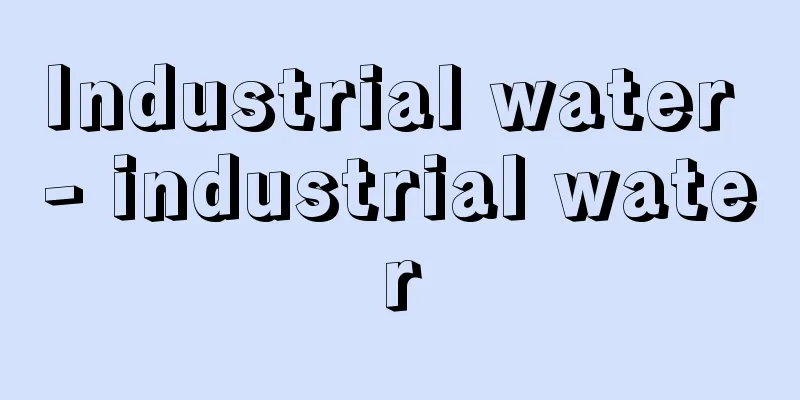Industrial water - industrial water

|
This refers to water used in manufacturing, and includes all water used for industrial production. In Japan, industries that use industrial water, that is, industries here, are defined as manufacturing, electricity supply, gas supply, and heat supply, and water used by these industries is defined as industrial water except for water used for hydroelectric power generation and drinking water. It is mainly fresh water, but seawater may be used in some cases. Water is essential for almost all industries, although the quantity and quality may vary. Generally, the most used water is for cooling, followed by water for cleaning and product processing. Other uses include water for raw materials, water for temperature control, and water for boilers. By industry, large amounts of water are used in industries involving high temperatures or cleaning processes, such as paper and pulp, chemicals, steel, and power generation. Industrial water obtained within factories from sources such as industrial waterworks, municipal water supplies, surface water, underground water, and well water is called make-up water. In contrast, water obtained once and then recycled repeatedly within the process is called recovered water, and cooling water is a good example of this. For water-use industries that use large amounts of industrial water, it is important to locate factories in areas where they can receive a large, inexpensive, and stable supply of water. However, in Japan, water is generally considered to be a universal resource, and the availability of industrial water has rarely been an important location factor for companies. During Japan's period of rapid economic growth, the demand for water increased sharply, causing land subsidence and depletion of groundwater in industrial areas due to excessive pumping of groundwater, as well as insufficient water supply capacity of industrial waterworks. This led to the construction of public industrial waterworks. Currently, these industrial waterworks account for the largest proportion of water sources for industrial water. In addition, since the oil crisis in Japan, rationalization of water use has been promoted in line with management rationalization, and the recovery rate (the proportion of recycled water used in industrial water) has increased, so that even industries that use large amounts of industrial water no longer continue to use large amounts of make-up water. [Masayuki Masaki and Koji Kato] "Japan's Industrial Water Supply" by Noboru Hida (1982, Taga Publishing) [Reference] | | |Source: Shogakukan Encyclopedia Nipponica About Encyclopedia Nipponica Information | Legend |
|
製造工業において用いられる水をいい、工業生産に関連するすべての用途の水が含まれる。日本では工業用水を用いる産業、つまりここでの工業は、製造業、電気供給業、ガス供給業および熱供給業と定義され、これらが使う水のうち、水力発電用、飲用を除くものを工業用水としている。 淡水を主とするが、一部海水で代用されることもある。ほとんどすべての工業にとって、量や質の違いがあっても水は必要不可欠であるが、一般に使用量が多いのは冷却用水で、洗浄用水や製品処理用水がこれに次ぐ。ほかに原料用水、温調用水、ボイラー用水などがある。 業種別には、紙・パルプ、化学工業、鉄鋼業、発電などの高温や洗浄処理を伴う業種で大量に使用される。工業用水のうち、工業用水道、上水道、地表水、伏流水、井戸水などの用水源から工場内に取得される水を補給水という。これに対して、いったん取得された水が工程内を繰り返し循環利用されるものを回収水といい、冷却用水が好例である。 工業用水を大量に使用する用水型工業にとっては、大量で低廉に安定した水の供給が受けられる地域に工場を立地することが重要である。ただし、日本では水を普遍的存在の資源と一般にはみなし、工業用水の存在が企業にとっての重要な立地因子となることは少なかった。 高度成長期の日本では、用水需要が急増し、工業地帯における地下水の過剰揚水による地盤沈下や地下水の枯渇、また工業用水道の給水能力不足が大きな問題になった。そこで公営による公共工業用水道の増設がなされるようになった。現在では、この工業用水道が工業用水のなかで最大の水源比率を占めている。また、日本ではオイル・ショック以降、経営合理化に伴う水使用の合理化が図られ、回収率(工業用水利用に占める回収水の使用割合)が高くなっており、工業用水を大量に使う業種であっても、補給水を大量に使用し続けるものではなくなってきている。 [柾 幸雄・加藤幸治] 『肥田登著『日本の工業用水供給』(1982・多賀出版)』 [参照項目] | | |出典 小学館 日本大百科全書(ニッポニカ)日本大百科全書(ニッポニカ)について 情報 | 凡例 |
>>: Public transport - public transport
Recommend
Sieve of Eratosthenes - Sieve of Eratosthenes
A method of finding prime numbers discovered by Er...
Tyrrhenian Sea - Mare Tirreno
An area in the central Mediterranean Sea. It is c...
Sakugi [village] - Sakugi
A village in Futami County in northern Hiroshima P...
van Eyck, H.
…Flemish painter. Also written as Van Eyck. He wa...
Macadamia - Macadamia
Macadamia is a fruit tree of the Proteaceae famil...
Price regulation
...In either supply form, by allowing a monopoly,...
Element of oxygen family
...A general term for the five elements in group ...
Petition for the Establishment of a Popularly Elected Assembly - Minsen Giinsetsuri Tsukenpaku
A movement to establish a national parliament in t...
Energetique - Energetique
…It is also called Energetik, a direct copy of th...
Pteropus
...Existing species are distributed in the subtro...
Aneyst japonica (English) Aneystjaponica
…[Tetsuichi Yahara]. … *Some of the terminology t...
Takeno Shokudan - Buyashokudan
This book records the accomplishments and words of...
Yukiyoshi Numata
A scholar and physician in the late Edo period. H...
Onmyodo - Onmyodo
A popular belief based on the ancient Chinese theo...
《The Job of a Filmmaker》 - The Job of a Filmmaker
...When Toho's crisis became serious in 1971 ...





![Tosa [city] - Tosa](/upload/images/67cc56c1133b5.webp)



